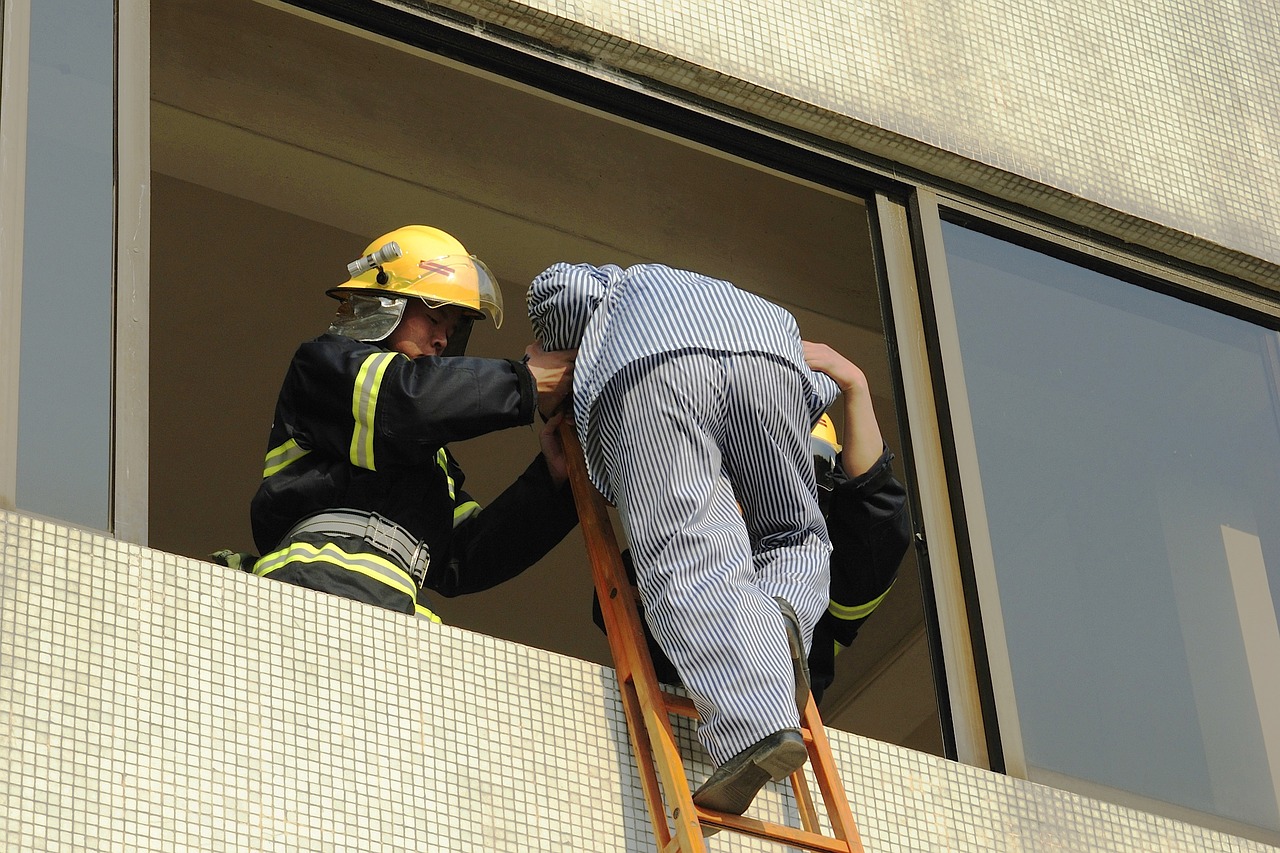Understanding Human Behavior for a Better Safety Culture
In today's fast-paced work environment, the significance of a robust safety culture cannot be overstated. It’s not just about following rules; it’s about understanding the intricate relationship between human behavior and safety practices. When we delve into the psychology behind our actions, we uncover the keys to fostering an environment where safety is not merely a checkbox but a core value. Imagine a workplace where every employee feels personally invested in safety—where they don’t just comply with protocols but actively champion them. This kind of culture is achievable, and it starts with recognizing how our behaviors and perceptions shape our approach to safety.
The foundation of a strong safety culture lies in the collective attitudes and behaviors of employees. When people believe that their safety is prioritized, they are more likely to engage in safe practices. This positive reinforcement creates a ripple effect—encouraging others to adopt similar behaviors. Think of it as a chain reaction: one person’s commitment to safety can inspire another, creating a community that values well-being above all else. But how do we cultivate such a culture? It begins with understanding the psychological factors that influence decision-making and behavior in safety contexts.
Understanding human behavior in relation to safety is like peeling an onion; there are layers to uncover. At the core, we find perception, which dictates how individuals view risks and hazards in their environment. This perception is often colored by various cognitive biases, which can lead to underestimating risks. For instance, have you ever felt invincible while driving, believing that accidents happen to others? This is an example of optimism bias, where individuals think they are less likely to experience negative events compared to others. By addressing these biases through effective training and awareness programs, organizations can reshape how employees perceive risks, leading to safer behaviors.
Another critical aspect is motivation. What drives employees to comply with safety protocols? Understanding the difference between intrinsic and extrinsic motivators can illuminate pathways to better safety compliance. Intrinsic motivation stems from within—like the personal satisfaction of doing a job well or the desire to protect one’s colleagues. On the other hand, extrinsic motivation comes from external factors, such as rewards or recognition for adhering to safety standards. By fostering both types of motivation, organizations can create a more engaging and proactive safety culture.
As we explore the dynamics of human behavior in safety, it's essential to consider the role of behavioral safety interventions. These interventions are designed to encourage safe behaviors through various strategies. For instance, implementing observational safety programs can empower employees to provide feedback to one another, fostering a sense of accountability. Imagine a workplace where employees actively watch out for each other, providing constructive feedback that enhances safety practices. This peer-to-peer interaction not only improves safety awareness but also builds trust among team members.
Finally, establishing effective feedback mechanisms is vital for continuous improvement in safety culture. Feedback should not be a one-way street; it must flow in all directions. By encouraging open communication about safety concerns and positive behaviors, organizations can create a culture of transparency and trust. When employees feel heard and valued, they are more likely to engage in safe practices and contribute to a culture that prioritizes safety above all else.
In conclusion, understanding human behavior is fundamental to cultivating a strong safety culture. By addressing psychological factors, enhancing motivation, and implementing behavioral interventions, organizations can create a workplace where safety is woven into the very fabric of daily operations. This proactive approach not only protects employees but also enhances overall organizational performance. So, let’s commit to understanding and improving our safety culture, one behavior at a time.

The Importance of Safety Culture
A strong safety culture is not just a buzzword; it's the backbone of any successful organization. When safety becomes a core value, it transforms the workplace into an environment where everyone feels responsible for their own safety and that of their colleagues. Imagine a workplace where every employee is not just aware of safety protocols but actively engages in promoting them. This kind of culture not only enhances safety but also boosts morale, leading to improved organizational performance.
So, what does a positive safety culture look like? It's characterized by open communication, where employees feel comfortable reporting hazards or unsafe behaviors without fear of retribution. In this environment, safety is prioritized, and it becomes part of the daily routine rather than an afterthought. Employees are more likely to take ownership of their actions and understand that their choices impact not only their safety but also the safety of their coworkers. This collective responsibility fosters a sense of belonging and teamwork, creating a dynamic where everyone looks out for one another.
Furthermore, a robust safety culture can lead to significant cost savings for organizations. When safety incidents are minimized, the costs associated with accidents—such as medical expenses, legal fees, and lost productivity—are drastically reduced. According to studies, companies with a strong safety culture experience fewer workplace injuries, which translates into lower insurance premiums and enhanced employee retention. The statistics are compelling: organizations that prioritize safety see a remarkable 30% reduction in incident rates compared to those that don't.
To cultivate such a culture, organizations must take proactive steps, including:
- Leadership Commitment: Leaders must not only endorse safety policies but also model safe behaviors themselves.
- Training and Education: Regular training sessions ensure that employees are well-informed about safety practices and protocols.
- Employee Involvement: Encouraging employees to participate in safety committees or initiatives fosters a sense of ownership.
In conclusion, the importance of a strong safety culture cannot be overstated. It is essential for creating a workplace where safety is ingrained in every action and decision. By prioritizing safety, organizations not only protect their employees but also enhance their overall performance and sustainability. Safety culture is not merely about compliance; it’s about creating a community that values and prioritizes the well-being of everyone involved.

Psychological Factors in Safety
The realm of safety is not just about rules and regulations; it's profoundly intertwined with human psychology. Understanding the psychological factors that influence safety can be a game-changer for organizations aiming to enhance their safety culture. At the core of this understanding are three pivotal elements: perception, motivation, and risk assessment. Each of these factors plays a critical role in how individuals approach safety, make decisions, and ultimately, how they behave in the workplace.
When we talk about perception, we are diving into how individuals interpret and understand risks. It's fascinating how two people can face the same situation and come away with completely different views of the danger involved. This variance often stems from cognitive biases—errors in thinking that can cloud judgment. For example, someone might underestimate the risks of working at heights due to an optimism bias, believing that accidents only happen to others. This skewed perception can lead to dangerous behaviors, like neglecting to wear a harness. To combat this, organizations must focus on reshaping these perceptions through targeted training and open dialogues about risk.
The way we perceive risk can significantly impact our behavior. Many individuals have a tendency to downplay risks, often due to a lack of awareness or understanding. Cognitive biases such as confirmation bias—where one favors information that confirms existing beliefs—can further exacerbate this issue. For instance, if an employee believes that their workplace is safe, they may ignore safety warnings or protocols, leading to potential hazards. This is where effective training comes into play. By providing employees with real-life scenarios and data, organizations can help reshape their understanding of risk and promote safer behaviors.
Identifying common cognitive biases is essential for organizations aiming to improve safety practices. Here are a few biases that can affect safety perception:
- Optimism Bias: The belief that negative events are less likely to happen to oneself.
- Confirmation Bias: The tendency to search for, interpret, and remember information that confirms one’s preconceptions.
- Anchoring Bias: Relying too heavily on the first piece of information encountered when making decisions.
By understanding these biases, organizations can tailor their safety training to address these misconceptions, ultimately leading to a more informed workforce.
Effective training is a powerful tool in reshaping risk perception. Tailored safety training programs can enhance awareness and alter how employees assess risks. For example, simulations that mimic real-life hazards can provide employees with a tangible understanding of the dangers they face. When employees experience scenarios where safety protocols are not followed, they are more likely to grasp the consequences of neglecting safety measures. This experiential learning not only reinforces the importance of safety but also empowers employees to take ownership of their safety practices.
In conclusion, understanding the psychological factors that influence safety is crucial for fostering a robust safety culture. By addressing perception, motivation, and risk assessment, organizations can create a proactive approach to safety that not only protects employees but also enhances overall organizational performance. The journey to a safer workplace begins with a deep dive into the minds of those who work there, understanding their fears, biases, and motivations. Only then can we pave the way for a culture that truly prioritizes safety.
- What are the main psychological factors affecting workplace safety?
The main psychological factors include perception, motivation, and risk assessment. Each of these plays a significant role in how employees approach safety protocols. - How can cognitive biases impact safety practices?
Cognitive biases can lead individuals to underestimate risks or ignore safety protocols. Understanding these biases is essential for effective safety training. - What role does training play in improving safety culture?
Training helps reshape employees' perceptions of risk and reinforces the importance of adhering to safety protocols through experiential learning and awareness.

Perception of Risk
When it comes to safety, how we perceive risk can be a game-changer. Just think about it: two people can face the same hazardous situation, yet respond in completely different ways. This difference often boils down to their individual perceptions of risk. It's like standing at the edge of a cliff; one person might feel exhilarated, while another feels terrified. Why is that? Our brains are wired with cognitive biases that shape how we interpret and react to potential dangers.
Cognitive biases are mental shortcuts that help us make quick decisions, but they can also lead us astray, especially in safety scenarios. For instance, consider the optimism bias. This is the belief that bad things are less likely to happen to us compared to others. If an employee believes they are less likely to suffer an injury than their coworkers, they may take unnecessary risks, thinking, “It won't happen to me.” This mindset can create a dangerous culture where safety is compromised.
Another common bias is the confirmation bias, where individuals tend to seek out information that confirms their existing beliefs while ignoring contradictory evidence. In a safety context, if someone believes that a particular safety protocol is unnecessary, they might overlook incidents or data that suggest otherwise. This can lead to a lack of adherence to crucial safety measures, ultimately jeopardizing the well-being of everyone in the workplace.
But here’s the kicker: understanding these biases is just the first step. Organizations can actively work to reshape risk perception through effective training programs. Imagine a workshop where employees are engaged in real-life scenarios that challenge their preconceived notions about risk. This kind of tailored training can not only enhance their awareness but also alter their risk assessment processes.
For instance, consider a training session that includes:
- Interactive simulations that mimic real-life hazards
- Group discussions that encourage sharing personal experiences and insights
- Expert-led sessions that debunk common myths about safety
By participating in these activities, employees can gain a more nuanced understanding of risk, leading to better decision-making when it comes to safety practices. They start to recognize that risk isn't just a statistic; it's a tangible factor that affects their lives and the lives of their colleagues. This shift in perception can foster a culture where safety is not just a protocol to follow but a shared responsibility among all employees.
In summary, the perception of risk is not merely about understanding statistics or following rules; it’s about reshaping mindsets. By addressing cognitive biases and enhancing training, organizations can empower their employees to take safety seriously, ultimately leading to a more robust safety culture.
- What is risk perception? Risk perception refers to how individuals interpret and respond to potential hazards based on their beliefs and experiences.
- How do cognitive biases affect safety? Cognitive biases can lead individuals to underestimate risks or ignore important safety protocols, increasing the likelihood of accidents.
- Can training change risk perception? Yes, effective training can reshape how employees perceive risk by providing them with new information and experiences that challenge their existing beliefs.

Common Cognitive Biases
When it comes to safety in the workplace, understanding cognitive biases is essential. These biases are mental shortcuts that can lead to flawed judgment, affecting how employees perceive risks. For instance, the optimism bias is a common phenomenon where individuals believe that they are less likely to experience negative events compared to others. This leads to an underestimation of risks, making employees less cautious in potentially hazardous situations. Imagine someone driving recklessly because they think, “That won’t happen to me.” This kind of thinking can be detrimental in a safety context.
Another significant bias is confirmation bias, where individuals tend to seek out information that supports their pre-existing beliefs while ignoring contradictory evidence. In a workplace setting, if an employee believes that a particular safety measure is unnecessary, they might overlook data indicating its importance. This can create a dangerous environment where risks are minimized or ignored entirely.
To further illustrate these biases, let’s consider a table that summarizes some common cognitive biases and their implications for workplace safety:
| Cognitive Bias | Description | Implications for Safety |
|---|---|---|
| Optimism Bias | Belief that one is less likely to experience a negative event. | Underestimation of risks leading to unsafe behaviors. |
| Confirmation Bias | Favoring information that confirms existing beliefs. | Ignoring safety data that contradicts personal views. |
| Anchoring Bias | Relying too heavily on the first piece of information encountered. | Difficulty in adjusting to new safety protocols based on initial training. |
| Availability Heuristic | Overestimating the likelihood of events based on recent experiences. | Misjudging the frequency of accidents, leading to complacency. |
Recognizing these biases is the first step toward mitigating their effects. Organizations can implement strategies to help employees become aware of their thought processes. For instance, regular training sessions that address these biases can open up discussions about risk perception and safety practices. By fostering an environment where employees can openly talk about their biases, companies can create a culture of safety that encourages vigilance and proactive behavior.
In conclusion, cognitive biases can significantly impact workplace safety. By understanding and addressing these biases, organizations can enhance their safety culture and ensure that employees are better equipped to recognize and respond to risks effectively.
- What are cognitive biases? Cognitive biases are systematic patterns of deviation from norm or rationality in judgment, leading to illogical conclusions.
- How do biases affect safety? They can lead to underestimating risks, ignoring safety protocols, and making poor decisions regarding safety practices.
- Can training help mitigate cognitive biases? Yes, training that addresses cognitive biases can increase awareness and improve decision-making regarding safety.

Impact of Training on Perception
Training plays a pivotal role in shaping how employees perceive risks in the workplace. Imagine walking into a room filled with potential hazards; without proper training, your perception of those risks might be clouded by ignorance or overconfidence. This is where tailored safety training steps in, acting as a guiding light that illuminates the dark corners of risk perception. When employees are equipped with the right knowledge and skills, they become more adept at recognizing dangers and understanding the importance of adhering to safety protocols.
One of the most significant impacts of training is its ability to challenge and reshape cognitive biases that often cloud judgment. For instance, consider the optimism bias, which leads individuals to believe that they are less likely to experience negative events compared to others. This bias can result in a dangerous underestimation of risks. However, through effective training programs that incorporate real-life scenarios and evidence-based practices, employees can learn to confront these biases head-on. They begin to see the reality of risks rather than relying on flawed perceptions.
Moreover, training can enhance employees' situational awareness, empowering them to make informed decisions in high-pressure situations. For example, when employees engage in hands-on training that simulates emergency scenarios, they learn not just to recognize risks but also to respond appropriately. This experiential learning fosters a deeper understanding of safety protocols and reinforces the idea that safety is not just a checkbox to tick but a crucial aspect of their daily responsibilities.
Another key aspect of training's impact on perception is its ability to foster a culture of open communication. When organizations prioritize safety training, they create an environment where employees feel comfortable discussing safety concerns and sharing experiences. This open dialogue can lead to collective learning, where team members share insights that might not have been considered individually. For instance, a safety training session might reveal common misconceptions about certain hazards, allowing the team to address these issues collaboratively.
In essence, the impact of training on perception is profound. It not only equips employees with the knowledge they need to recognize and assess risks but also cultivates a safety-first mindset that permeates the entire organization. By investing in comprehensive training programs, companies can significantly enhance their safety culture and reduce the likelihood of accidents. Ultimately, well-trained employees are more likely to advocate for safety measures and contribute to a collective commitment to maintaining a safe working environment.
- What is the primary goal of safety training? The primary goal of safety training is to equip employees with the knowledge and skills necessary to identify and mitigate risks in the workplace.
- How can training change an employee's perception of risk? Training can change an employee's perception of risk by providing them with factual information and real-life scenarios that challenge cognitive biases and enhance situational awareness.
- What are cognitive biases, and why are they important in safety? Cognitive biases are mental shortcuts that can lead to errors in judgment. They are important in safety because they can cause individuals to underestimate risks, making training essential to counteract these biases.
- How does open communication during training benefit workplace safety? Open communication during training fosters a culture of safety where employees feel comfortable discussing concerns and sharing experiences, leading to collective learning and improved safety practices.

Motivation and Safety Compliance
When it comes to workplace safety, motivation is the fuel that drives compliance. Think of it this way: if safety protocols are like a car, motivation is the engine that makes it go. Without a powerful engine, even the best-designed car will sit idle. In the context of safety, this means that employees must feel motivated to adhere to safety protocols for those protocols to be effective. But what exactly motivates people to follow safety guidelines? The answer lies in understanding the difference between intrinsic and extrinsic motivators.
Intrinsic motivators are those that come from within an individual. They are driven by personal satisfaction, a sense of accomplishment, or the desire to contribute to a safer work environment. For instance, an employee who takes pride in their work may be more likely to follow safety protocols because they genuinely care about the well-being of their colleagues and themselves. On the other hand, extrinsic motivators are external factors that encourage compliance. These can include rewards, recognition, or even consequences for not following safety procedures. A company might implement a reward system where employees receive bonuses for maintaining accident-free records, effectively leveraging extrinsic motivation to promote a culture of safety.
However, striking the right balance between intrinsic and extrinsic motivation is crucial. Over-reliance on extrinsic motivators can sometimes lead to a superficial compliance culture where employees follow the rules just for the rewards, rather than understanding the importance of safety. This is where effective communication plays a vital role. Organizations need to communicate the significance of safety protocols, not just as a requirement but as a shared responsibility. When employees understand that their actions can directly impact their colleagues' safety, they are more likely to be intrinsically motivated to comply.
Moreover, creating a supportive environment can enhance motivation. When employees feel valued and supported, they are more likely to engage in safe behaviors. This can be achieved through regular safety meetings, open-door policies for discussing safety concerns, and providing the necessary resources and training. For example, a company might hold monthly safety workshops that not only educate employees about safety procedures but also allow them to voice their concerns and suggestions. This kind of involvement fosters a sense of ownership and accountability among employees, making them more likely to comply with safety regulations.
To summarize, motivation is a critical component of safety compliance. By understanding the different types of motivators—intrinsic and extrinsic—organizations can tailor their safety programs to encourage a culture of compliance. Engaging employees through effective communication, recognition, and support can lead to a more proactive approach to safety, ultimately resulting in a safer workplace for everyone.
- What are intrinsic and extrinsic motivators?
Intrinsic motivators come from within an individual, such as personal satisfaction, while extrinsic motivators are external factors like rewards or recognition. - How can organizations enhance employee motivation for safety compliance?
Organizations can enhance motivation by fostering a supportive environment, providing effective training, and recognizing safe behaviors. - Why is it important to balance intrinsic and extrinsic motivation?
Balancing both types of motivation ensures that employees understand the importance of safety beyond just following rules for rewards.

Behavioral Safety Interventions
When it comes to enhancing workplace safety, are like the secret sauce that can transform an ordinary safety culture into an extraordinary one. These interventions focus on the actions and behaviors of employees, recognizing that how individuals act on the job can make or break safety outcomes. Think of it this way: just as a sports team relies on each player to perform their role effectively, a workplace thrives when every employee is engaged in safe practices. So, how do we encourage these safe behaviors?
One effective strategy is the implementation of observational safety programs. These programs are designed to promote peer-to-peer feedback, allowing employees to observe one another's behaviors and provide constructive insights. Imagine a scenario where a colleague notices you not wearing your safety goggles while operating machinery. Instead of waiting for a supervisor to step in, they can gently remind you, fostering a culture of accountability and vigilance. This not only helps in immediate risk reduction but also builds a community where safety is everyone's responsibility.
Another vital component of behavioral safety interventions is establishing robust feedback mechanisms. Feedback is essential for continuous improvement. When employees receive timely and constructive feedback about their safety practices, it reinforces positive behaviors and highlights areas for improvement. For instance, consider a table summarizing the types of feedback and their impacts:
| Type of Feedback | Impact on Safety Culture |
|---|---|
| Positive Reinforcement | Encourages repeat of safe behaviors |
| Constructive Criticism | Identifies areas for improvement |
| Peer Reviews | Fosters a sense of community accountability |
It's essential to remember that feedback should be delivered in a supportive manner. When employees feel safe to express concerns or acknowledge mistakes, they're more likely to engage in open dialogue about safety. This creates an environment where safety becomes a shared value rather than a top-down mandate. Furthermore, regular safety meetings can serve as a platform for discussing safety concerns and celebrating successes, reinforcing the importance of a proactive safety culture.
Incorporating technology can also enhance behavioral safety interventions. For instance, mobile apps can be utilized to report safety observations in real-time, allowing for swift action and documentation. This not only streamlines the reporting process but also empowers employees to take ownership of their safety and that of their colleagues. The more involved employees feel, the more likely they are to adopt safe practices consistently.
In conclusion, behavioral safety interventions are not just a checkbox on a safety program; they are the heartbeat of a thriving safety culture. By focusing on observable behaviors, encouraging open communication, and leveraging technology, organizations can create a workplace where safety is ingrained in every action. So, let’s prioritize these interventions and watch as safety becomes second nature to every employee.
- What are behavioral safety interventions?
Behavioral safety interventions are strategies aimed at improving workplace safety by focusing on the actions and behaviors of employees. - How do observational safety programs work?
These programs encourage employees to observe and provide feedback on each other's safety practices, fostering a culture of accountability. - Why is feedback important in safety culture?
Feedback helps reinforce positive behaviors and identify areas for improvement, creating an environment of continuous safety enhancement. - Can technology aid in behavioral safety interventions?
Yes, mobile apps and other technologies can streamline reporting and empower employees to take ownership of safety practices.

Observational Safety Programs
Observational safety programs are a game changer in the realm of workplace safety. Imagine a scenario where employees are not just following safety protocols but actively engaging with one another to promote a safer work environment. That’s the essence of observational safety programs. These initiatives encourage team members to observe each other’s behaviors, providing real-time feedback that can lead to immediate improvements in safety practices. By fostering a culture of accountability, these programs empower employees to take ownership of their safety and the safety of their colleagues.
At the heart of observational safety programs is the belief that safety is a shared responsibility. When employees feel that they are part of a collective effort, they are more likely to adhere to safety protocols. This not only enhances individual awareness but also builds a supportive community where safety is prioritized. Research has shown that organizations that implement such programs see a marked decrease in incidents and accidents. The key here is not just the act of observation, but the constructive feedback that follows.
To illustrate the effectiveness of these programs, consider the following statistics:
| Year | Incident Rate Before Program | Incident Rate After Program |
|---|---|---|
| 2019 | 5.0 | 3.2 |
| 2020 | 4.8 | 2.5 |
| 2021 | 4.5 | 1.8 |
As seen in the table above, the implementation of observational safety programs has consistently led to a reduction in incident rates over the years. This data underscores the importance of creating an environment where safety is not just a checkbox on a compliance list, but a fundamental aspect of the workplace culture.
Moreover, observational safety programs can be tailored to fit the specific needs of an organization. For instance, some companies may focus on specific high-risk areas, while others may implement broader safety observations. Regardless of the approach, the goal remains the same: to create a proactive safety culture. Employees are trained to recognize unsafe behaviors and report them without fear of retribution, fostering an atmosphere of trust and collaboration.
In conclusion, observational safety programs are not merely about monitoring compliance; they are about creating a culture where safety is embedded in everyday actions. By encouraging peer-to-peer feedback, organizations can cultivate a sense of community that prioritizes safety above all else. When every employee feels empowered to speak up and contribute to safety initiatives, the entire workplace benefits. So, why not take the leap and implement an observational safety program in your organization? The results could be transformative.
- What are observational safety programs?
These are initiatives designed to encourage employees to observe and provide feedback on each other's safety practices, fostering a culture of accountability and collaboration.
- How do these programs improve safety?
By promoting peer-to-peer feedback, observational safety programs help identify unsafe behaviors and reinforce positive safety practices, leading to a reduction in incidents.
- Can these programs be customized?
Yes! Observational safety programs can be tailored to meet the specific needs of an organization, focusing on high-risk areas or broader safety observations as necessary.
- What is the key to a successful observational safety program?
The key is creating a culture of trust, where employees feel comfortable providing feedback without fear of retribution, and where safety is seen as a shared responsibility.

Feedback Mechanisms
In the realm of workplace safety, serve as the backbone of continuous improvement. They are essential for creating an environment where employees feel empowered to voice their concerns and share their observations. Imagine a workplace where everyone is not just following rules but actively engaging in conversations about safety. This is the kind of culture that effective feedback mechanisms can foster.
Feedback mechanisms can take various forms, from informal chats during breaks to structured surveys and safety meetings. The key is to ensure that these channels are not just available but also actively utilized. When employees know that their input is valued and can lead to tangible changes, they are more likely to participate. This engagement not only enhances safety awareness but also builds a sense of community within the organization.
One effective strategy is to implement regular feedback sessions where employees can discuss safety issues openly. These sessions can be informal, perhaps held over coffee, or more structured, like monthly safety meetings. The goal is to create a safe space where employees feel comfortable sharing their thoughts without fear of retribution. Additionally, organizations can utilize anonymous surveys to gather honest feedback, allowing employees to express concerns they might hesitate to voice in person.
To illustrate the effectiveness of feedback mechanisms, consider the following table that outlines some common feedback types and their impact on safety culture:
| Feedback Type | Description | Impact on Safety Culture |
|---|---|---|
| Informal Chats | Casual discussions among peers about safety practices. | Fosters camaraderie and encourages open dialogue. |
| Structured Meetings | Regularly scheduled meetings focused on safety topics. | Promotes accountability and ensures safety remains a priority. |
| Anonymous Surveys | Surveys that allow employees to provide feedback without revealing their identity. | Encourages honest feedback and highlights areas for improvement. |
Moreover, establishing a robust feedback mechanism can significantly enhance the understanding of safety concerns on the ground. When employees report near misses or unsafe conditions, it provides invaluable data that can be analyzed to prevent future incidents. This proactive approach transforms feedback into a powerful tool for risk management.
It's also crucial to recognize and reward employees who actively participate in these feedback processes. Acknowledging their contributions not only boosts morale but also reinforces the importance of safety in the workplace. When employees see that their feedback leads to real change, it creates a positive feedback loop: they are more likely to continue providing input, knowing it can make a difference.
In conclusion, effective feedback mechanisms are vital for nurturing a safety culture that is responsive and dynamic. By fostering open communication and valuing employee input, organizations can create an environment where safety is not just a policy but a collective responsibility. As we move forward, let’s remember that every piece of feedback is a step toward a safer workplace.
- What are feedback mechanisms? Feedback mechanisms are systems or processes that allow employees to share their thoughts, observations, and concerns about safety in the workplace.
- How can feedback improve workplace safety? Feedback helps identify potential hazards and areas for improvement, fostering a culture of safety and proactive risk management.
- What types of feedback mechanisms are most effective? A combination of informal chats, structured meetings, and anonymous surveys is often the most effective approach to gather comprehensive feedback.
- How can organizations encourage employee participation in feedback processes? By creating a safe environment for open dialogue, recognizing contributions, and demonstrating that feedback leads to actionable change.
Frequently Asked Questions
- What is safety culture and why is it important?
Safety culture refers to the shared values, beliefs, and practices regarding safety within an organization. It's crucial because a strong safety culture prioritizes safety, leading to fewer accidents, improved employee morale, and enhanced organizational performance. When employees feel that safety is a core value, they are more likely to engage in safe practices and report hazards.
- How do psychological factors influence safety behavior?
Psychological factors such as perception, motivation, and risk assessment play a significant role in shaping safety behavior. For instance, how individuals perceive risks can lead to either heightened caution or reckless behavior. Understanding these factors helps organizations tailor their safety training and interventions to better align with employees' mental processes.
- What are some common cognitive biases that affect safety?
Cognitive biases like optimism bias (the belief that bad things are less likely to happen to oneself) and confirmation bias (favoring information that confirms existing beliefs) can lead employees to underestimate risks. Recognizing these biases is essential for developing effective safety programs that address these misconceptions.
- How can training improve risk perception?
Effective training can significantly reshape how employees perceive risks. By providing real-life scenarios and emphasizing the consequences of unsafe behaviors, training can enhance awareness and alter risk assessment processes. This proactive approach helps employees make better decisions in safety scenarios.
- What motivates employees to comply with safety protocols?
Employees are motivated by both intrinsic factors (such as personal values and a sense of responsibility) and extrinsic factors (like rewards and recognition). Understanding these motivators allows organizations to create a more compelling case for safety compliance, making it a shared goal rather than just a requirement.
- What are observational safety programs?
Observational safety programs are initiatives that encourage employees to observe and provide feedback on each other's safety practices. These programs foster a culture of accountability and collaboration, leading to improved safety awareness and behavior across the organization.
- How does feedback contribute to safety culture?
Establishing effective feedback mechanisms is vital for continuous improvement in safety culture. Feedback reinforces positive behaviors, addresses safety concerns, and encourages open communication. When employees feel heard and valued, they are more likely to engage in safe practices and contribute to a safer workplace.



















